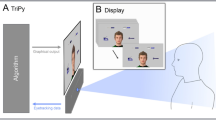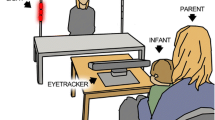Abstract
Clinically, social interaction, including gaze-triggered attention, has been reported to be impaired in autism spectrum disorder (ASD), but psychological studies have generally shown intact gaze-triggered attention in ASD. These studies typically examined gaze-triggered attention under simple environmental conditions. In real life, however, the environment is complex. Previous studies have shown that an enhanced cueing effect was found when using eye gaze compared with arrow cues in unpredictably complex conditions in typically developing (TD) individuals. However, in the current study, compared with TD individuals, the cueing effect failed to enhance when using eye gaze compared with arrow cues under complex conditions in individuals with ASD. This may reflect the atypical style of gaze-triggered attention when individuals with ASD adapt to environmental complexity.


Similar content being viewed by others
Abbreviations
- ASD:
-
Autism spectrum disorder
- ANOVA:
-
Analysis of variance
- IQ:
-
Intelligent quotient
- RT:
-
Reaction time
- SOA:
-
Stimulus onset asynchrony
- SD:
-
Standard deviation
References
American Psychiatric Association (2000). The diagnostic and statistical manual for mental disorders: DSM-IV-TR. Washington, DC: APA.
Baron-Cohen, S., Campbell, R., Karmiloff-Smith, A., Grant, J., & Walker, J. (1995). Are children with autism blind to the mentalistic significance of the eyes? British Journal of Developmental Psychology, 13(4), 379–398.
Bayliss, A. P., Schuch, S., & Tipper, S. P. (2010). Gaze cueing elicited by emotional faces is influenced by affective context. Visual Cognition, 18(8), 1214–1232.
Birmingham, E., & Kingstone, A. (2009). Human social attention. Annals of the New York Academy of Sciences, 1156(1), 118–140.
Chawarska, K., Klin, A., & Volkmar, F. (2003). Automatic attention cueing through eye movement in 2-year-old children with autism. Child Development, 74(4), 1108–1122.
Courchesne, E., Townsend, J., Akshoomoff, N., & Saitoh, O. (1994). Impairment in shifting attention in autistic and cerebellar patients. Behavioral Neuroscience, 108(5), 848–865.
Ekman, P., & Friesen, W. V. (1976). Pictures of facial affect. Palo Alto, CA: Consulting Psychologists Press.
Farroni, T., Mansfield, E. M., Lai, C., & Johnson, M. H. (2003). Infants perceiving and acting on the eyes: Tests of an evolutionary hypothesis. Journal of Experimental Child Psychology, 85(3), 199–212.
Gillespie-Lynch, K., Elias, R., Escudero, P., Hutman, T., & Johnson, S. P. (2013). Atypical gaze following in autism: A comparison of three potential mechanisms. Journal of Autism and Developmental Disorders, 43(12), 2779–2792.
Goldberg, M., et al. (2008). Evidence for impairments in using static line drawings of eye gaze cues to orient visual-spatial attention in children with high functioning autism. Journal of Autism and Developmental Disorders, 38(8), 1405–1413.
Guillon, Q., Hadjikhani, N., Baduel, S., & Rogé, B. (2014). Visual social attention in autism spectrum disorder: Insights from eye tracking studies. Neuroscience & Biobehavioral Reviews, 42, 279–297.
Hanley, M., McPhillips, M., Mulhern, G., & Riby, D. M. (2013). Spontaneous attention to faces in Asperger syndrome using ecologically valid static stimuli. Autism: the international journal of research and practice, 17(6), 754–761.
Hayward, D., Shore, D., Ristic, J., Kovshoff, H., Iarocci, G., Mottron, L., & Burack, J. (2012). Flexible visual processing in young adults with autism: The effects of implicit learning on a global–local task. Journal of Autism and Developmental Disorders, 42(11), 2383–2392.
Kim, K., & Mundy, P. (2012). Joint attention, social cognition and recognition memory in adults. Frontiers in Human Neuroscience, 6, 172. doi:10.3389/fnhum.2012.00172.
Koldewyn, K., Jiang, Y. V., Weigelt, S., & Kanwisher, N. (2013). Global/local processing in autism: Not a disability, but a disinclination. Journal of Autism and Developmental Disorders, 43(10), 2329–2340.
Kryzak, L. A., Bauer, S., Jones, E. A., & Sturmey, P. (2013). Increasing responding to others’ joint attention directives using circumscribed interests. Journal of Applied Behavior Analysis, 46(3), 674–679.
Kuhn, G., Benson, V., Fletcher-Watson, S., Kovshoff, H., McCormick, C., Kirkby, J., & Leekam, S. (2010). Eye movements affirm: Automatic overt gaze and arrow cueing for typical adults and adults with autism spectrum disorder. Experimental Brain Research, 201(2), 155–165.
Kuhn, G., & Tipples, J. (2011). Increased gaze following for fearful faces. It depends on what you’re looking for! Psychonomic Bulletin & Review, 18(1), 89–95.
Kylliäinen, A., & Hietanen, J. K. (2004). Attention orienting by another’s gaze direction in children with autism. Journal of Child Psychology and Psychiatry, 45(3), 435–444.
Lord, C., Rutter, M., & Le Couteur, A. (1994). Autism Diagnostic interview-Revised: A revised version of a diagnostic interview for caregivers of individuals with possible pervasive developmental disorders. Journal of Autism and Developmental Disorders, 24, 659–685.
Magrelli, S., Jermann, P., Noris, B., Ansermet, F., Hentsch, F., Nadel, J., et al. (2013). Social orienting of children with autism to facial expressions and speech: A study with a wearable eye-tracker in naturealistic settings. Frontiers in Psychology, 4, 840. doi:10.3389/fpsyg.2013.00840.
Marotta, A., et al. (2013). Inhibition of return in response to eye gaze and peripheral cues in young people with asperger’s syndrome. Journal of Autism and Developmental Disorders, 43(4), 917–923.
Mundy, P., Kim, K., McIntyre, N., Lerro, L., & Jarrold, W. (2016). Brief report: Joint attention and information processing in children with higher functioning autism spectrum disorders. Journal of Autism and Developmental Disorders, 46(7), 2555–2560.
Mundy, P., Sullivan, L., & Mastergeorge, A. M. (2009). A parallel and distributed-processing model of joint attention, social cognition and autism. Autism Research, 2(1), 2–21.
Naoi, N., Tsuchiya, R., Yamamoto, J. I., & Nakamura, K. (2008). Functional training for initiating joint attention in children with autism. Research in Developmental Disabilities, 29(6), 595–609.
Nation, K., & Penny, S. (2008). Sensitivity to eye gaze in autism: Is it normal? Is it automatic? Is it social? Development and Psychopathology, 20(1), 79–97.
Okada, T., Sato, W., Murai, T., Kubota, Y., & Toichi, M. (2003). Eye gaze triggers visuospatial attention shift in individuals with autism. Psychologia, 46(4), 246–254.
Plaisted, K., Swettenham, J., & Rees, L. (1999). Children with autism show local precedence in a divided attention task and global precedence in a selective attention task. Journal of Child Psychology and Psychiatry, 40(5), 733–742.
Posner, M. (1980). Orienting of attention. The Quarterly Journal of Experimental Psychology, 32, 3–25.
Reed, P., & McCarthy, J. (2012). Cross-modal attention-switching is impaired in autism spectrum disorders. Journal of Autism and Developmental Disorders, 42(6), 947–953.
Ristic, J., Mottron, L., Friesen, C. K., Iarocci, G., Burack, J. A., & Kingstone, A. (2005). Eyes are special but not for everyone: The case of autism. Cognitive Brain Research, 24, 715–718.
Rombough, A., & Iarocci, G. (2013). Orienting in response to gaze and the social use of gaze among children with autism specturn disorder. Journal of Autism and Developmental Disorders, 43(7), 1584–1596.
Rutherford, M. D., & Krysko, K. M. (2008). Eye direction, not movement direction, predicts attention shifts in those with autism spectrum disorders. Journal of Autism and Developmental Disorders, 38(10), 1958–1965.
Senju, A., Tojo, Y., Dairoku, H., & Hasegawa, T. (2004). Reflexive orienting in response to eye gaze and an arrow in children with and without autism. Journal of Child Psychology and Psychiatry, 45(3), 445–458.
Shinagawa, F., Kobayashi, S., Fujita, K., & Maekawa, H. (1990). Japanese wechsler adult intelligence scale-revised. Tokyo: Nihon-Bunka-Kagaku-sha.
Uono, S., Sato, W., & Toichi, M. (2009). Dynamic fearful gaze does not enhance attentoni orienting in individuals with Asperger’s disorder. Brain and Cognition, 71(3), 229–233.
Zhao, S., Uono, S., Yoshimura, S., Kubota, Y., & Toichi, M. (2013). Can gaze-cueing be helpful for detecting sound in autism spectrum disorder? Research in Autism Spectrum Disorders, 7(10), 1250–1256.
Zhao, S., Uono, S., Yoshimura, S., Kubota, Y., & Toichi, M. (2014). Attention orienting by eye gaze and arrows reveals flexibility to environmental changes. Acta Psychologica, 150, 100–105.
Zhao, S., Uono, S., Yoshimura, S., & Toichi, M. (2015a). Is impaired joint attention present in non-clinical individuals with high autistic traits? Molecular Autism, 6, 67. doi:10.1186/s13229-015-0059-3.
Zhao, S., Uono, S., Yoshimura, S., & Toichi, M. (2015b). Self make-up: The influence of self-referential processing on attention orienting. Scientific Reports, 5, 14169. doi:10.1038/srep14169.
Acknowledgments
We acknowledge and thank the participants. This study was supported by a Grant-in-Aid for Overseas JSPS Fellows (1515307) and the Organization for Promoting Developmental Disorder Research.
Author contributions
SZ collected and analysed the data and prepared the figures. SZ, SU, SY, YK, and MT designed the experiments and wrote the manuscript.
Author information
Authors and Affiliations
Corresponding author
Ethics declarations
Conflict of interest
The authors declare that they have no competing interest.
Rights and permissions
About this article
Cite this article
Zhao, S., Uono, S., Yoshimura, S. et al. Atypical Gaze Cueing Pattern in a Complex Environment in Individuals with ASD. J Autism Dev Disord 47, 1978–1986 (2017). https://doi.org/10.1007/s10803-017-3116-2
Published:
Issue Date:
DOI: https://doi.org/10.1007/s10803-017-3116-2




